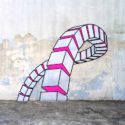“There is an inherent familiarity that we all have with shapes independently from our background and that’s a great starting point.” – Aakash Nihalani
Next week, Wunderkammern gallery in Milan will be opening a new show next week featuring the work of renowned US artist Aakash Nihalani, an artist whose work has the ability to catch someone’s attention at a moment’s notice.
Titled “Tilt”, the new exhibition will be presenting site-specific works created with adhesive tape as well as murals painted directly on the gallery walls. Using bright, bold lines at the forefront of all of his art as a means of visually creating 3D images on two-dimensional surfaces. His work investigates the concept of space perception, creating unique and immersive experiences in which the viewer is challenged to participate actively in.
Part of what makes Nihalani’s works so appealing is the intentional interplay between the conventional shapes he utilizes and the unconventional means of portraying them to his audience. Your brain is expecting a geometric arrangement, but in Nihalani’s reality, you get much more than that: a break from what is anticipated, immersing the viewer, through “tilted” disruptions and optical illusions, into into a deeper space of reflection on the use and consumption of today’s digital imagery.
“Tilt” runs from March 28th, 6.30 – 9.30 pm to April 28th at Wunderkammern gallery located on via Ausonio 1A, 20123 in Milan.





About the artist
Aakash Nihalani (USA, 1986) lives and works in New York. In 2008 he obtained a BFA at Steinhardt School, New York University (NYU) and in 2012 he gained a residency from Lisa de Kooning at the Willem de Kooning studio in East Hampton, NY. Known internationally, he has exhibited in solo and group exhibitions in numerous countries including Saudi Arabia, India, United States, England, Italy and Hong Kong. Currently some of his works are visible at the Rose Kennedy Greenway in Boston (2017).
The relationship of Aakash Nihalani with the urban architecture of New York was fundamental for his artistic development. The repetitive architecture of the city, its geometric shapes and its dimensions have attracted the artist who has begun to relate to it. The artist has found his meeting point with the public precisely in the universality of geometric language, accessible at every age.
Author: Fran
Founder and editor of Urbanite. Street Art lover who after the finishing her MA thesis on the Mexican and Norwegian muralist movement in the 1920-50s, developed a fascination for street art and graffiti that eventually led to collaborations with different art blogs, including the creation of this one.




You must be logged in to post a comment.